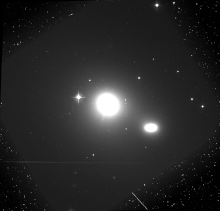| 3C 66B | |
|---|---|
 Hubble Legacy Archive visible light image of 3C 66B | |
| Observation data (J2000 epoch) | |
| Constellation | Andromeda |
| Right ascension | 02h 23m 11.4112s[1] |
| Declination | +42° 59′ 31.385″[1] |
| Redshift | 0.021258[1] |
| Distance | 300 Mly (92 Mpc)[2] |
| Apparent magnitude (V) | 15.0 (B) |
| Characteristics | |
| Type | FRI RG[2] gamma-ray source[3] |
| Apparent size (V) | 2.4´X1.82´ |
| Other designations | |
| 3C 66, 4C 42.07, QSO B0220+427[4], MAGIC J0223+430, 2MASX J02231141+4259313, UGC 1841, LEDA 9067, PGC 9067[3] | |
3C 66B is an elliptical Fanaroff and Riley class 1 radio galaxy[2] located in the constellation Andromeda. With an estimated redshift of 0.021258,[1] the galaxy is about 300 million light-years away.[2]
The orbital motion of 3C 66B showed supposed evidence for a supermassive black hole binary (SMBHB) with a period of 1.05 ± 0.03 years,[5] but this claim was later proven wrong (at 95% certainty).[6]
Messier 87 (M87), about 55 million light-years away, is the largest giant elliptical galaxy near the Earth, and also contains an active galactic nucleus. The smooth jet of 3C 66B rivals that of M87.[7]
3C 66B is an outlying member of Abell 347 which is part of the Perseus–Pisces Supercluster.[8]

References
- ^ a b c d "NASA/IPAC Extragalactic Database". Results for PGC 9067. Retrieved June 25, 2021.
- ^ a b c d "3C 66B". XJET: X-Ray Emission from Extragalactic Radio Jets. 2009-04-16. Retrieved 2010-04-05.
- ^ a b Errando, Manel; Lindfors; Prandini; Tavecchio (2009). "A TeV source in the 3C 66A/B region". arXiv:0907.0994 [astro-ph.HE].
- ^ "UGC 1841 -- Seyfert 1 Galaxy". SIMBAD. Retrieved June 25, 2021.
- ^ Sudou, H.; Iguchi, S.; Murata, Y.; Taniguchi, Y. (2003). "Orbital Motion in the Radio Galaxy 3C 66B: Evidence for a Supermassive Black Hole Binary". Science. 300 (5623): 1263–1265. arXiv:astro-ph/0306103. Bibcode:2003Sci...300.1263S. doi:10.1126/science.1082817. PMID 12764190. S2CID 36578161.
- ^ Jenet, F.; Lommen, A.; Larson, S. L.; Wen, L. (2004). "Constraining the Properties of Supermassive Black Hole Systems Using Pulsar Timing: Application to 3C 66B". The Astrophysical Journal. 606 (2): 799–803. arXiv:astro-ph/0310276. Bibcode:2004ApJ...606..799J. doi:10.1086/383020. S2CID 119457912.
- ^ Perlin, Eric S.; Padgett; Georganopoulos; Sparks; Biretta; et al. (2006). "Optical Polarimetry of the Jets of Nearby Radio Galaxies. I. The Data". The Astrophysical Journal. 651 (2): 735–748. arXiv:astro-ph/0606119. Bibcode:2006ApJ...651..735P. doi:10.1086/506587. S2CID 53073859.
- ^ Fanti, C.; Fanti, R.; Feretti, L.; Ficarra, A.; Gioia, I. M.; Giovannini, G.; Gregorini, L.; Mantovani, F.; Marano, B. (1982-01-01). "Radio and optical observations of 9 nearby Abell clusters - A262, A347, A569, A576, A779, A1213, A1228, A2162, A2666". Astronomy and Astrophysics. 105: 200–218. Bibcode:1982A&A...105..200F. ISSN 0004-6361.
External links
- www.jb.man.ac.uk/atlas/ (J. P. Leahy)
- 3C66B = B0220+427 (Alan Bridle / 31 May 2006)
- Wikisky image of PGC 9067
